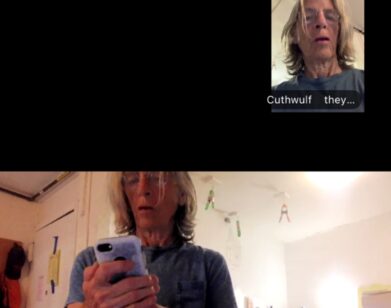The Myth of Ranji Ye

Seoul-based Ranji Yeoung, designer for The Centaur, is less interested in making a statement than in exploring how statements are made. Her inspiration is finding what remains inarticulate among fashion’s language of signs, signifiers and stimuli. “I want to make only idealistically driven collections,” she says through an English-speaking friend. “I want to discover what must be said and what must be kept secret for each woman. I want to my clothes to help her to not hide from her own secrets, but rather to confront them privately within herself or expose them to others.” (ALL LOOKS: FALL/WINTER 2009)
Though Ranji Ye has no art school training, she heads one of the most mature and artistic collections presented during the Generation Next showcase for emerging, experimental designers. Her debut show during Seoul’s Spring/Summer 08 collections, was designed around the theme, “The very social Dalai Lama.” This season’s show, staged at the Kring Art Center, had the poetically cryptic English title “the logic of my private parts.”
In an attempt to explain her intentions with the title, Ranji Ye says, “The logic of my private parts is that they are illogical. I was looking for words to express the meaning of my inner self, the parts that are private and secret” And while her use of the terms “private parts” does not precisely refer to sexual organs, she named her line “The Centaur” because the mythological creature represents the tensions between animal desires and intellectual motives. To open “the logic of my private parts” show, Ranji Ye selected a performer whose gender ambiguity embodied another set of captivating contradictions. The fiercely slinky male dancer wore a gray wool catsuit with subtly belled legs almost covering floral silk heels, and fit seamlessly with Ranji Ye’s artistic Almodóvaresque sensibility.
The show centered around flowing dresses with bold floral patterns, commanding three-piece suits worn by models with long, loose braids and a menu of hues including merlot, mint, olive, and cinnamon. The sculpted wool jackets’ peaked shoulders typify the strong shoulders dominating reports of this season’s international trends, although they were only slightly more articulated than Ranji Ye’s previous show for The Centaur. This time around, she paired sharp shouldered jackets with trousers snipped at the knees and a fabric bra worn underneath or as part of a full Bordeaux-hued three-piece suit.
I saw in the show a strong influence of Frida Kahlo, for both her personal style and her bold palette. “I have loved her since my youth and I still do,” Ranji Ye told me while describing the broad range of references inspiring her. “It is very obvious that she comes alive in my work because she is inside of me.” The most powerful inspiration for the collection was an image of Kahlo wearing a man’s suit for a family portrait, in which Ranji Ye saw idiosyncratic attempts at self-defense. Says Ranji Ye, “I was moved by how she stood in her father’s suit next to her sisters who were wearing pretty, feminine skirts and dresses because she wanted to hide her crippled legs.”






